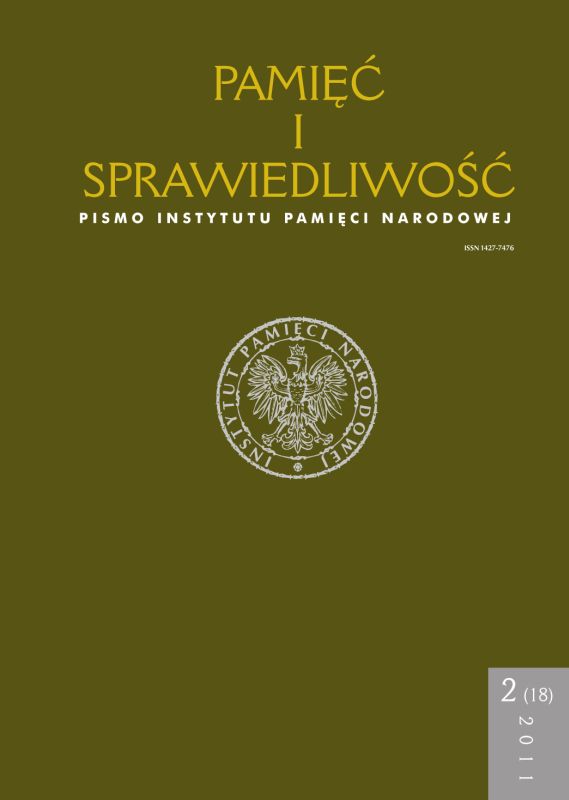Zachodnia Ukraina – początek sowietyzacji (wrzesień–grudzień 1939 roku). Spojrzenie historyka ukraińskiego
Pamięć i Sprawiedliwość, Том 18 № 2 (2011), pages: 383-410
Publication date: 2011-12-30
Аннотация
Библиографические ссылки
M. Mieltiuchow, Sowietsko-polskije wojny. Wojenno-politiczeskoje protiwostojanije 1918– –1939 gg., Moskwa 2001 T. Jasudowicz, Widmo krąży po Europie. Bezprawie paktu Ribbentrop –Mołotow, Toruń 1993 P. Eberhardt, Polska granica wschodnia 1939–1945, Warszawa 1993 A. Knorowski, Paragrafy niezgody. Agresja sowiecka na Polskę w 1939 r. w świetle ówczesnych norm międzynarodowego prawa wojennego, Warszawa 2002 I. Iljuszyn, O. Pszennikow, Dijalnist´ operatywno-czekistśkych hrup NKWD u zachidnych obłastiach Ukrajiny (wereseń–żowteń 1939 r.), „Z Archiwiw WUCzK-GPU-NKWD-KGB” 2000, nr 2/4, s. 424–433 W. Danyłenko, Likwidacija Polśkoji derżawy ta wstanowłennia radianśkoho reżymu w Zachidnij Ukrajini, „Ukrajinśkyj Istorycznyj Żurnał” 2006, nr 3, s. 123 S. Jaczyński, Zagłada oficerów Wojska Polskiego na Wschodzie, wrzesień 1939 – maj 1940, Warszawa 2000 W. Baran, W. Tokarśkyj, Ukrajina. Zachidni zemli 1939–1941 rr., Lwiw 2009 W. Bonusiak, Polityka ludnościowa i ekonomiczna ZSRS na okupowanych ziemiach polskich w latach 1939–1941 („Zachodnia Ukraina” i „Zachodnia Białoruś”), Rzeszów 2006 G. Hryciuk, Polacy we Lwowie 1939–1944. Życie codzienne, Warszawa 2000 A. Głowacki, Sowieci wobec Polaków na ziemiach wschodnich Rzeczypospolitej 1939–1941, Łódź 1998 C. Grzelak, Kresy w czerwieni. Agresja Związku Sowieckiego na Polskę w 1939 roku, Warszawa 2001 Sbornik zakonow SSSR i ukazow Prezidiuma Wierchownogo Sowieta SSSR 1938–1944 gg., Moskwa 1945 I. Biłas, Represywno-karalna systema w Ukrajini 1917–1953. Suspilno-politycznyj ta istoryko-prawowyj analiz, t. 1, Kyjiw 1994 T. Wronśka, S. Kulczyćkyj, Radianśka pasportna systema, „Ukrajinśkyj Istorycznyj Żurnał” 1999, nr 4, s. 6
Наиболее читаемые статьи этого автора (авторов)
- Wołodymyr Baran, Wasyl Tokarski, Sądownictwo radzieckie na Wołyniu i w Galicji Wschodniej w latach 1939–1941 , Pamięć i Sprawiedliwość: Том 25 № 1 (2015)
- Wołodymyr Baran, Technologia represji politycznych NKWD w latach 1939–1941 , Pamięć i Sprawiedliwość: Том 23 № 1 (2014)
- Wołodymyr Baran, Radzieckie organy bezpieczeństwa państwowego na Ukrainie: czerwiec–grudzień 1941 roku. Zarys problematyki , Pamięć i Sprawiedliwość: Том 30 № 2 (2017)
- Wołodymyr Baran, Przekształcenia ekonomiczne na Ukrainie Zachodniej w latach 1939–1941 , Pamięć i Sprawiedliwość: Том 19 № 1 (2012)
 Język Polski
Język Polski
 English
English
 Deutsch
Deutsch
 Français (France)
Français (France)
 Italiano
Italiano
 Русский
Русский


 PDF (Język Polski)
PDF (Język Polski)
